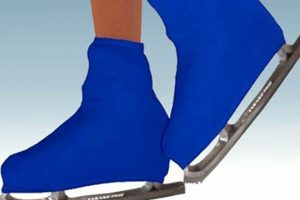Public ice skating sessions, often referred to as “open skate ice skating”, offer dedicated periods where ice rinks are accessible to the general public for recreational skating. During these sessions, individuals of varying skill levels can utilize the ice surface for leisure, practice, or enjoyment. For instance, a local arena might schedule several hours each week for public access, allowing families and individuals to participate in a shared activity.
Participation in these sessions provides multiple advantages. They promote physical fitness through cardiovascular exercise and muscle engagement. Social benefits are also derived from interaction with other skaters and the community. Historically, accessible ice time has contributed to the growth of ice sports and provided an entry point for aspiring athletes. These sessions foster community engagement and offer a healthy recreational outlet.
The remainder of this article will explore specific aspects related to public ice skating, including essential safety guidelines, appropriate attire recommendations, skill development tips for beginners, and an overview of the various rink facilities that commonly host these sessions.
Open Skate Ice Skating Tips
The following guidance aims to enhance the experience and safety of individuals participating in public ice skating sessions.
Tip 1: Equipment Assessment. Ensure skates fit properly, providing adequate ankle support. Loosely laced skates can lead to instability and potential injuries.
Tip 2: Warm-Up Exercises. Prior to entering the ice, engage in light stretching and joint mobilization. This prepares muscles and reduces the risk of strains.
Tip 3: Initial Gliding Practice. Before attempting complex maneuvers, practice gliding to familiarize with the ice surface. Maintain a stable center of gravity.
Tip 4: Gradual Skill Progression. Advance skill development incrementally. Attempting advanced techniques without a solid foundation increases the chance of falls.
Tip 5: Awareness of Surroundings. Maintain vigilance of other skaters and potential obstacles. Avoid sudden stops or changes in direction that could cause collisions.
Tip 6: Proper Falling Technique. In the event of a fall, aim to fall to the side and bend knees. Protect the head and avoid extending arms to brace the fall, as this can lead to fractures.
Tip 7: Active Cooling Down. Following the session, engage in light activity such as walking. This aids in muscle recovery and reduces stiffness.
Tip 8: Hydration Maintenance. Drink water both before, during, and after ice skating. Dehydration can impair performance and increase the risk of muscle cramps.
Adherence to these recommendations will promote a safer and more enjoyable experience during public ice skating sessions.
The subsequent sections of this article will delve into advanced skating techniques and strategies for continuous improvement.
1. Accessibility for all
The provision of public ice skating, frequently promoted as “open skate ice skating,” necessitates a commitment to accessibility for all members of the community. This accessibility extends beyond mere physical availability; it encompasses factors such as affordability, scheduling convenience, and inclusivity for individuals of varying skill levels and physical abilities. The availability of such sessions is directly contingent upon the rink’s operational policies and the allocation of ice time. Rinks prioritizing broad access often offer sessions during off-peak hours or implement tiered pricing structures to accommodate diverse socioeconomic backgrounds. Failure to ensure accessibility limits participation and diminishes the potential community benefits derived from public skating opportunities. For example, a rink with limited hours or high admission fees effectively restricts access to a segment of the population, negating the intended widespread recreational benefits.
The significance of accessibility is underscored by its impact on public health and community engagement. Broad access to ice skating promotes physical activity, reduces social isolation, and fosters a sense of community. Rinks that actively implement inclusive practices, such as providing adaptive equipment or offering introductory skating programs, demonstrate a commitment to serving a wider range of participants. These efforts contribute to a more vibrant and equitable recreational environment. Conversely, neglecting accessibility perpetuates disparities in recreational opportunities, potentially exacerbating existing health and social inequalities. As a practical example, offering discounted rates to youth programs or providing free skate rentals to underprivileged individuals can significantly enhance participation among underserved populations.
In conclusion, the link between public ice skating and accessibility for all is critical. Addressing barriers to participation, through considerate scheduling, affordable pricing, and inclusive programs, is crucial to maximizing the community benefit of this recreational activity. Overcoming these challenges will ultimately result in a more inclusive and healthier population, benefiting all community members from increased access.
2. Rink Safety Regulations
Rink safety regulations are paramount during public ice skating sessions, frequently known as “open skate ice skating”, ensuring a secure environment for participants of all ages and skill levels. These regulations mitigate potential hazards and minimize the risk of accidents or injuries on the ice.
- Mandatory Protective Equipment
Requiring or recommending the use of helmets, particularly for children and novice skaters, is a common safety measure. Wrist guards and knee pads offer additional protection against falls. Failure to enforce or promote protective gear usage can result in increased injury rates and potential liability for the rink operators. As an example, some rinks offer helmet rentals at minimal cost to encourage compliance.
- Ice Surface Maintenance
Regular resurfacing of the ice is crucial for maintaining a smooth, even skating surface. Uneven surfaces, cracks, or excessive slush can increase the risk of falls and injuries. Rinks typically employ ice resurfacing machines to address these issues. The frequency of resurfacing often depends on the intensity of usage and the ambient temperature, with more frequent resurfacing needed during peak hours.
- Skater Conduct and Capacity Limits
Rules governing skater behavior, such as prohibiting excessive speed, reckless maneuvers, or horseplay, contribute to a safer skating environment. Monitoring skater behavior and enforcing capacity limits are essential for preventing overcrowding and potential collisions. Many rinks employ staff members to oversee the ice surface and address any unsafe conduct.
- Emergency Procedures and First Aid Availability
Having clearly defined emergency procedures in place, including protocols for handling injuries, evacuating the rink, and contacting emergency services, is essential. Availability of trained first aid personnel and appropriate medical equipment is also critical. Regular staff training in first aid and CPR ensures a rapid and effective response to any medical emergencies that may arise.
These facets of rink safety regulations are interconnected and contribute to the overall safety of “open skate ice skating” sessions. Neglecting any one of these aspects can compromise the well-being of skaters. Rink operators have a responsibility to prioritize safety and implement comprehensive measures to minimize risks and ensure a positive experience for all participants. Consistent enforcement of these regulations is vital for preventing accidents and fostering a safe and enjoyable skating environment.
3. Skill Level Diversity
The concept of “open skate ice skating” inherently encompasses a wide spectrum of skill levels among its participants. This diversity presents both challenges and opportunities for rink management and individual skaters. Beginner skaters may require more space and exhibit unpredictable movements, potentially posing a hazard to more experienced individuals. Conversely, advanced skaters practicing complex maneuvers necessitate an awareness of less skilled participants to prevent collisions. The success of public skating sessions hinges on fostering a respectful and accommodating environment where varying skill levels can coexist safely. A failure to adequately manage this skill level diversity can result in increased accidents, diminished enjoyment, and a potential deterrent for newcomers to the sport. For example, a rink that does not clearly delineate areas for beginner and advanced skaters may experience frequent collisions and complaints from both groups.
Effective strategies for managing skill level diversity in “open skate ice skating” sessions include designated skating zones, structured lesson programs, and clear communication of rink rules. Designated zones can separate beginners from advanced skaters, reducing the likelihood of collisions and providing beginners with a less intimidating space to learn. Introductory skating lessons, offered at reasonable prices, can equip novices with the foundational skills necessary to navigate the ice safely and confidently. Regularly broadcasting rink rules and etiquette guidelines via signage or public address announcements reinforces responsible skating behavior. A practical example of this is a rink offering a ‘learn to skate’ area cordoned off from the main ice surface, along with frequent announcements reminding skaters to be aware of their surroundings and the skill levels of others.
In conclusion, skill level diversity is an unavoidable and defining characteristic of “open skate ice skating” sessions. Acknowledging and actively managing this diversity through appropriate rink design, targeted programs, and clear communication is crucial for ensuring a safe, enjoyable, and inclusive experience for all participants. Ignoring the complexities of skill level diversity may lead to negative consequences, whereas proactive management fosters a more welcoming and accessible recreational environment. Such an environment encourages broader participation and supports the continued growth and popularity of ice skating.
Public ice skating, frequently referred to as “open skate ice skating,” serves as a significant catalyst for community social interaction. These sessions provide a shared recreational space where individuals from diverse backgrounds can converge, fostering a sense of collective identity. The act of skating together, regardless of skill level, creates opportunities for spontaneous interaction and camaraderie. For instance, assisting a struggling skater or sharing a laugh over a shared fall can break down social barriers and promote a sense of connection. This communal activity fosters an environment conducive to informal networking and the development of social bonds, effectively transforming the ice rink into a community hub.
The importance of “Community social interaction” as a component of “open skate ice skating” is evident in its impact on social cohesion and individual well-being. Participation in these sessions can combat social isolation, particularly among vulnerable populations such as the elderly or those new to the community. The shared experience of skating, coupled with the opportunity for casual conversation, can alleviate feelings of loneliness and foster a sense of belonging. Furthermore, witnessing children and adults engaging in a healthy, shared activity strengthens community ties and reinforces positive social norms. A notable example is the increased attendance at public skating sessions during holiday periods, where families and friends gather to celebrate and create lasting memories together.
In conclusion, “open skate ice skating” provides a valuable platform for “Community social interaction,” contributing significantly to social cohesion and individual well-being. The shared recreational experience fostered by these sessions transcends age, skill level, and socioeconomic background, creating opportunities for meaningful social connections. Recognizing and promoting this aspect of public ice skating is crucial for maximizing its positive impact on communities. Challenges may arise from ensuring inclusivity and accessibility for all members of the community, which necessitates proactive measures to address barriers such as cost, transportation, and perceived skill limitations. Overcoming these challenges will further enhance the role of “open skate ice skating” as a vital component of community life.
5. Recreational fitness benefits
Participation in “open skate ice skating” provides a range of recreational fitness benefits. The repetitive motion involved in skating engages multiple muscle groups, contributing to improved cardiovascular health and muscular endurance. The act of maintaining balance on the ice requires core strength and stability, leading to enhanced postural control. Caloric expenditure during a typical skating session can be significant, assisting in weight management and the reduction of associated health risks. A direct causal link exists between consistent participation in “open skate ice skating” and improved physical well-being. For example, individuals who regularly engage in this activity may experience lowered blood pressure, improved cholesterol levels, and increased bone density.
The importance of “recreational fitness benefits” as a component of “open skate ice skating” cannot be overstated. It transforms a purely leisure activity into a means of promoting overall health and fitness. The low-impact nature of skating makes it suitable for individuals of varying ages and fitness levels, including those with joint pain or other mobility limitations. Moreover, the social aspect of public skating sessions can enhance motivation and adherence to a fitness routine. Rinks that actively promote the fitness benefits of skating, through signage or educational programs, can further encourage participation and maximize the health outcomes for their patrons. Practical application of this understanding involves rink operators collaborating with healthcare professionals to develop targeted skating programs for specific populations, such as seniors or individuals recovering from injuries.
In conclusion, “open skate ice skating” offers substantial recreational fitness benefits, contributing to improved cardiovascular health, muscular endurance, and overall well-being. Recognizing and promoting these benefits can enhance participation and transform public skating sessions into a valuable resource for community health. Challenges remain in ensuring accessibility and affordability for all individuals, particularly those from underserved populations. Overcoming these challenges will solidify the role of “open skate ice skating” as a vital component of recreational fitness and community health promotion.
Frequently Asked Questions Regarding Open Skate Ice Skating
The following section addresses common inquiries related to public ice skating sessions, also known as “open skate ice skating,” offering concise and informative answers.
Question 1: What is the typical duration of an open skate ice skating session?
Open skate sessions typically range from one to two hours. Session length may vary depending on the rink’s schedule and operational policies. It is advisable to consult the rink’s schedule or contact the facility directly for specific session durations.
Question 2: Are rental skates available during open skate ice skating?
Most ice rinks offer rental skates in a variety of sizes. Availability may be limited during peak hours. Individuals should ensure that rental skates fit properly and provide adequate ankle support.
Question 3: Is protective gear required or recommended during open skate ice skating?
Helmets are strongly recommended, particularly for children and novice skaters. Some rinks may mandate helmet use for certain age groups. Wrist guards and knee pads are also advisable for added protection.
Question 4: What is the skill level required to participate in open skate ice skating?
Open skate sessions are generally open to all skill levels, from beginners to experienced skaters. However, it is important to exercise caution and be mindful of other skaters, particularly those with less experience.
Question 5: Are there age restrictions for open skate ice skating?
Age restrictions may vary depending on the rink. Some rinks may require children under a certain age to be accompanied by an adult. Consult the rink’s policies for specific age requirements.
Question 6: Are outside food and beverages permitted during open skate ice skating?
Policies regarding outside food and beverages vary by rink. Many rinks have concession stands and prohibit outside food and drinks. Inquire about the rink’s specific policy prior to arrival.
These FAQs provide a general overview of common concerns related to public ice skating sessions. Individuals are encouraged to contact their local ice rink for specific information regarding policies, schedules, and pricing.
The subsequent section will present case studies illustrating the economic impact of ice rinks on local communities.
Conclusion
This article has explored various facets of “open skate ice skating,” emphasizing its importance as a recreational activity, a contributor to community well-being, and a promoter of physical fitness. Key areas examined include accessibility, safety regulations, skill level diversity management, the fostering of social interaction, and the provision of recreational fitness benefits. Understanding these aspects is crucial for both participants and rink operators seeking to maximize the positive impacts of public ice skating sessions.
The continued availability and responsible management of “open skate ice skating” remain essential for community enrichment. Promoting safe practices, ensuring accessibility for diverse populations, and recognizing the numerous benefits contribute to a healthier and more connected society. Further research into the long-term impacts of public skating programs could inform policy decisions and resource allocation to further enhance their positive effects on communities worldwide. The importance of this activity should not be underestimated, given its potential for promoting both individual well-being and community cohesion.







